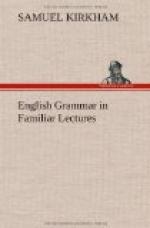2. Common nouns are sometimes used to signify individuals, when articles or pronouns are prefixed to them; as, “The boy is studious; That girl is discreet.” In such instances, they are nearly equivalent to proper nouns.
3. Common nouns are sometimes subdivided into the following classes: Nouns of Multitude; as, The people, the parliament: Verbal or participial nouns; as, The beginning, reading, writing; and Abstract nouns, or the names of qualities abstracted from their substances; as, knowledge, virtue, goodness. Lest the student be led to blend the idea of abstract nouns with that of adjectives, both of which denote qualities, a farther illustration appears to be necessary, in order to mark the distinction between these two parts of speech. An abstract noun denotes a quality considered apart (that is, abstracted) from the substance or being to which it belongs; but an adjective denotes a quality joined (adjected) to the substance or being to which it belongs. Thus, whiteness and white both denote the same quality; but we speak of whiteness as a distinct object of thought, while we use the word white always in reference to the noun to which it belongs; as, white paper, white mouse.
4. Some authors have proceeded to still more minute divisions and sub-divisions of nouns; such, for example, as the following, which appear to be more complex than useful: Natural nouns, or names of things formed by nature; as, man, beast, water, air: 2. Artificial nouns, or names of things formed by art; as, book, vessel, house: 3. Personal nouns, or those which stand for human beings; as, man, woman, Edwin: 4. Neuter nouns, or those which denote things inanimate; as, book, field, mountain, Cincinnati. The following, however, is quite a rational division: Material nouns are the names of things formed of matter; as, stone, book: Immaterial nouns are the names of things having no substance; as, hope, immortality.
To nouns belong gender, person, number, and case.
GENDER.
GENDER is the distinction of sex. Nouns have three genders, the masculine, the feminine, and the neuter.
The masculine gender denotes males; as, a man, a boy.
The feminine gender denotes females; as, a woman, a girl.
The neuter gender denotes things without sex; as, a hat, a stick.
Neuter means neither: therefore neuter gender signifies neither gender; that is, neither masculine nor feminine. Hence, neuter gender means no gender. Strictly speaking, then, as there are but two sexes, nouns have but two genders; but for the sake of practical convenience, we apply to them three genders, by calling that a gender which is no gender. The English and the pure Persian, appear to be the only languages which observe, in the distinction of sex, the natural division of nouns.—The genders of nouns are so easily known, that a farther explanation of them is unnecessary, except what is given in the following




